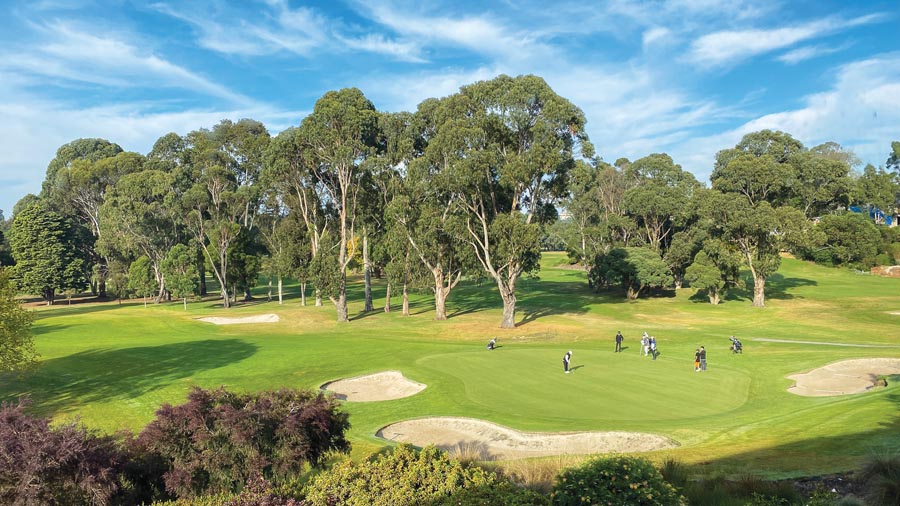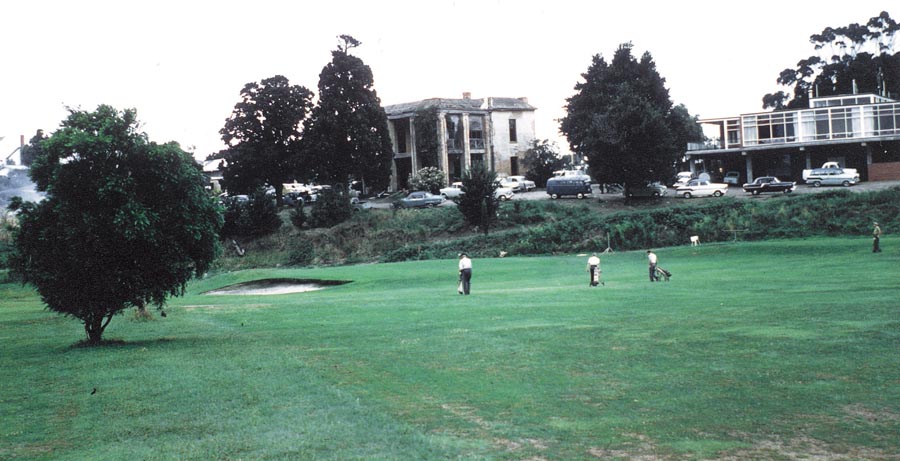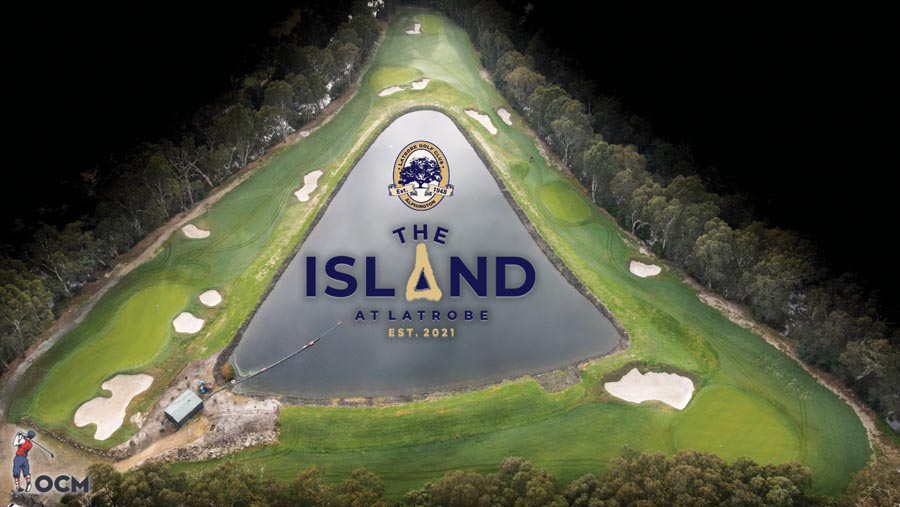From small beginnings come great things

GIVEN its colourful history and distinctly working-class origins, Latrobe Golf Club, in many respects, is unlike any other private golf club.
Latrobe is located on one of Melbourne’s most historic sites. Melbourne was first settled in 1835, and in June 1840 Thomas Wills purchased, for £3784, 176 acres (70 ha) of land which formed a rough semi-circle between Darebin Creek, its junction with the Yarra River and the Yarra River.
The land takes in all of what is now Latrobe Golf Club, plus Farm Road, Lucerne Crescent, the Tower Hotel and bordered on the west by what is now Como Street.
Almost immediately, Wills began clearing the property and landscaping the hill it overlooked in preparation for building a mansion. ‘Lucerne’, as he called it, was the grandest home of its day.
Proudly sitting atop the rise where the golf club upper car park is now, it was made of bluestone and hand-made bricks from one of the colony’s first kilns. The interior walls were lath and plaster with much stained woodwork and an imposing staircase.
History states that Thomas Wills’ young cousin, Kate, whilst visiting from NSW, planted the English Oak tree on the property in 1842 in the location of the current 8th and 13th tee area. The English Oak is now 180 years old and listed on the National Trust. It is proudly the symbol of the club and features majestically on the club’s logo.
In 1948, because of dispute with the lease-holders, a number of long-standing Latrobe members decided to leave the club.

With total assets of a meagre 200 pounds, the remaining members, perhaps 50 or less, gathered on March 3, 1948 for what was to become the first official annual general meeting.
At the meeting James Foley was appointed president, Merv Lavender vice-president, and other office bearers were Cec Stalker (captain) and Bill Gott (honorary secretary) and committee members Frank Leviny, Keith Carlton, Alf Smith and Roy Wilson. Despite the fact that Latrobe Golf Club had been in existence for almost a decade, this meeting is now regarded as the beginning of the club.
The new committee now renegotiated the deal with Latrobe Golf Investments and, eventually, it was agreed that the course be made available for the exclusive use of members. New members were recruited, and by mid-1948 the books were full: 250 male members and 75 associates.
Changes were also made to the course and by October that year Latrobe had 12 holes in play.
In February 1950, following much hard work by Foley in drafting them, the club had approved by the State Attorney General’s Department its initial Memorandum and Articles of Association to become a company limited by guarantee … and hence was entitled to own land.
Membership numbers and finances were always of considerable concern and two other clubs contributed substantially to the fledgling club by joining with Latrobe. In March 1950, Ivanhoe Golf Club, which played at the public course in Ivanhoe, and, in early 1953, Highland Park Golf Club, which played in what is now Kingsbury on government land that was to be built on for public housing.
However, tensions continued between the lease-holders and the club. Issues included the number of members, fees, number of holes to be played – and particularly ownership of the land and surrounding properties.
Following a meeting in December 1948 at which the administrator of Latrobe Golf Investments made substantial demands which, if not met, would reopen the course to the public.
The committee investigated the possibility of acquiring more land to the east. Consequently, over the next few years, a series of outright purchases resulted in the club owning all of its land. This new land was enough for construction of a new nine holes of more than 3000 yards.
Many years later a club grew from that farm, due mainly to the work of James Foley and his band of hardy golf enthusiasts.
A motley crew, many had just returned from World War II. Others worked locally in the surrounding suburbs, many at the now demolished papermills close by in Alphington.
For most of the original members the fledgling club became part of their way of life. It was an undeniably social place in those days – a friendly and welcoming sanctuary where one could always count on a drink.

The course
The golf course has undergone major changes from the original, rudimentary nine holes that were developed as a public course in the 1930s.
The original 18 holes, laid out after the private club was formed in 1948, was a par 71 stretching to 6226 yards (5693 metres). It was subjected to radical alteration in the early 1970s when the then Melbourne and Metropolitan Board of Works (now Melbourne Water) decided to cut a swathe through the Yarra Valley to make way for the Eastern Freeway.
Construction involved the re-routing of the Yarra River and a major re-design of the course. They were difficult days for golfers.
Eventually, the reconstruction was completed, and on March 1, 1975 the new course was opened by Club Patron, Sir Edmund Herring. It was now a course of 6040 metres, par 71.
Since then, minor modifications have occurred with its current championship length for men being 6092 metres and par and scratch rating each being 72. For the women it’s 5272 metres (par 72) and has a scratch rating of 73.
To stay ahead of the game, a golf club needs to stand out from the crowd.
In addition to the championship course, the rabbit in the hat for Latrobe is the five-hole par-3 short course that was located on the island paddock in 2020.
The brainchild of former club professional Tony Craswell, the new OCM designed five-hole short course mirrors developments in golf course management in the USA and Europe.
Flooding is something Latrobe has learned to live with as the course hugs the Yarra River and resides on the flood plain. Floods have produced muddy fairways and preferred lies in winter but members have also had to contend with the counter phenomenon – drought.
At times in summer, Latrobe would get so dry that the usually lush Poa fairways shrivelled to narrow, green landing strips in an otherwise hard, dusty landscape. Major flooding in October and November 2022, led the club to make one of its biggest decisions about the golf course in living memory.
The flood recovery cost including the loss of business was more than $1million. But with insurance funds and available cash reserves, the club was able to bring forward the Santa Ana couch grass plan.
This was an enormously significant moment for Latrobe. It meant that members were able to play on firm, mud-free fairways and will be able to do so all year round – something club founders would never have dreamed of.
The clubhouse
In late 1949 and early 1950, the club acquired an old weatherboard ex-Army building used during the war. This was dismantled and re-erected by members at its property in Roemer Crescent.
However, it was not long before it became clear that a more permanent clubhouse was needed. This became possible following the acquisition of the Lucerne Farm property. In October 1958, the club approved the construction of the two-storey building that is the basis of today’s clubhouse on land behind the old Lucerne mansion.
In keeping with the club’s historic vice-regal links, the new building was opened on Saturday, December 12, 1959 by the then Lieutenant-Governor of Victoria, Sir Edmund Herring, who was also the club’s patron.
Other notable attendees, who played in two ‘exhibition’ groups, were Bill Edgar, Tom Crow, John Hood, Bruce Devlin, Doug Bachli and Kevin Hartley – certainly as impressive a group of golfers as was around at that time.
Controversially, the club, in 1960, demolished the once stately mansion of “Lucerne” that was built by the Wills family. Lucerne was once regarded as one of the finest homes in the colony and hosted many social events attended by notables including Governor Charles La Trobe, after whom the course is named.
While the loss of heritage was typical of the times, it paved the way for the construction of a new clubhouse which has panoramic vistas over the course. A series of renovations since that time has transformed the building into a modern, stylish structure.

The club’s vision
Latrobe Golf Club will be a vibrant and progressive hub for excellence in club membership, playing facilities, golf development and hospitality.
The club’s values
Respectful – Inclusive – Progressive – Responsible – Fun.
Latrobe has encountered many challenges during its 75-year history and has emerged with a magnificent river belt course and clubhouse.
The club prides itself on delivering the best golfing experience and is well set for the future with a strategic plan, financial resources and a board populated with people with vision. It is an exciting time being a member of Latrobe Golf Club.
Latrobe Golf Club is located on Farm Road, Alphington, Victoria. For more information call (03) 9497-1000 or visit the website www.latrobegolf.com.au
“This article was prepared by Inside Golf for Latrobe Golf Club with the help of the club’s general manager Bill Papadimitriou and historian Paul Robinson.”
– David Newbery




![Win the golfing experience of a lifetime, at the Hawai‘i International Week of Golf, valued at $6,900 [Winner Announced] Win the golfing experience of a lifetime, at the Hawai‘i International Week of Golf, valued at $6,900 [Winner Announced]](https://www.insidegolf.com.au/wp-content/uploads/Hawaii-Comp-500x294.jpg)